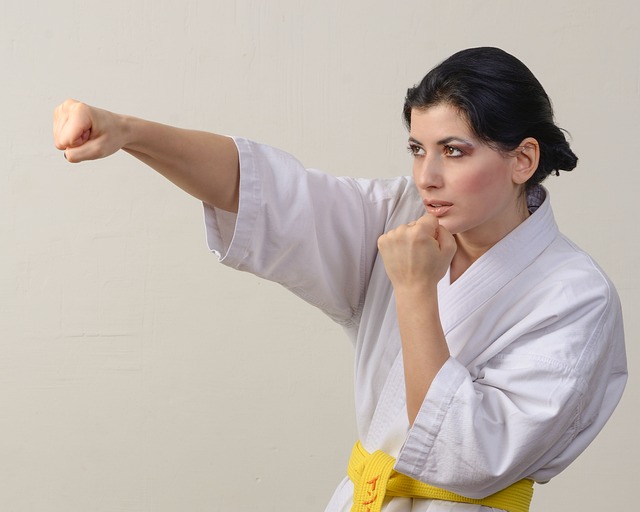The Karate Gi, also known as a keikogi in Japan and a dogi in Okinawa, is a traditional martial arts uniform with origins in Judo and Kendo garments. Historically and culturally significant, the white cotton or hemp Gi, consisting of the jacket "Uwagi" and trousers "Shuko," has evolved to offer both flexibility and durability for Karate practitioners, allowing for a full range of martial art movements while maintaining the traditional symbolism of purity and humility. The suit's design includes emblems that indicate the wearer's rank within their dojo, and the belt, which ranges from white (indicating beginner status) to black (signifying advanced proficiency), further signifies the practitioner's level of skill and dedication. While modern adaptations have introduced lightweight materials for comfort and protection, the karate suit name retains its significance as a symbol of the wearer's commitment to Karate and its disciplined tradition, underscoring the uniform's dual role as both functional attire and emblematic artifact in the world of martial arts.
When stepping onto the martial arts mat, the uniform one dons is more than mere attire; it’s a symbol of discipline and respect deeply rooted in tradition. Known colloquially as a “karate gi,” this garment serves as both a cultural touchstone and a functional piece of training gear. This article delves into the essential aspects of the karate suit, from its origins and design to its role in etiquette, and offers insights on selecting and maintaining the right gi for your practice. Whether you’re a beginner or a seasoned martial artist, understanding the significance and nuances of this martime piece is key to embracing the full essence of karate.
- Understanding the Karate Suit: Origins and Design
- The Evolution of the Karate Gi: Tradition, Function, and Style
Understanding the Karate Suit: Origins and Design

The attire worn by practitioners of Karate is commonly referred to as a “Karate Gi” or “Karate uniform.” This garment’s origins are deeply rooted in Japanese culture, specifically in the martial art of Judo. Over time, it has been adopted and adapted for use in various other martial arts, including Karate. The traditional Gi is composed of a jacket and trousers made of cotton or hemp fabric, typically white in color, which signifies purity and humility. It is designed to facilitate the movements required in Karate practice and competition, allowing for both flexibility and ease of movement while providing enough structure to enable an instructor to assess the practitioner’s technique and posture.
The design of a Karate Gi consists of a series of crests or emblems that often reflect the wearer’s rank or level within their dojo. The jacket, known as “Uwagi,” features long sleeves with a closed or open chest, depending on the style and preference of the practitioner. The trousers, called “Shuko,” are straight-legged and secure to the waist with a belt, which is also an integral part of the Karate practice, representing the white belt that all beginners start with. Over time, variations of the Gi have emerged, including lightweight designs for summer training or specialized versions for different martial arts, but the essence of the garment remains consistent with its origins and purpose in Karate. The Karate suit name thus serves as a symbol of respect for the discipline and tradition, as well as an identifier of the wearer’s status within the practice.
The Evolution of the Karate Gi: Tradition, Function, and Style

The term “karate suit” often refers to the traditional garb worn by practitioners during training and competition. Known in Japan as a “keikogi” and in Okinawa as a “dogi,” this garment has a history that reflects both the discipline’s cultural origins and its functional requirements. Historically, the karate suit was derived from the judo and kendo uniforms, adapting elements from these established martial arts. Over time, the design of the karate gi evolved to meet the specific needs of the practice, distinguishing it from other martial arts attire.
The evolution of the karate gi is a testament to the sport’s adaptation and growth. Initially, the garment was relatively simple, consisting of a heavy cotton fabric with a belt, or obi, tied around the waist. As the art spread globally, the design underwent changes to enhance both the wearer’s mobility and the garment’s durability. Today, the karate suit is typically made from lightweight, yet robust fabrics that allow for ease of movement during dynamic techniques. The traditional white color remains, symbolizing purity and humility, while subtle variations in style can be found across different schools and regions. The uniform’s design now often includes reinforced areas for better protection and a more modern cut to accommodate a variety of body types. Whether for traditional practice or competitive bouts, the karate suit continues to serve as a functional and symbolic element of the martial art’s rich tradition.
In summary, the traditional attire worn in karate, commonly known as a ‘karate gi,’ serves as both a uniform and a tangible link to the practice’s origins. Its design reflects a blend of Japanese tradition and functional necessity, evolving over time to meet the needs of practitioners while maintaining its cultural significance. The karate suit, or ‘gi,’ is not merely a garment but a symbol of discipline, respect, and the martial arts spirit. Understanding the nuances of its origins and design offers insight into the heart of karate itself. As the article has explored, the terminology ‘karate suit name’ encapsulates the essence of this garment’s identity within the karate community and beyond.
